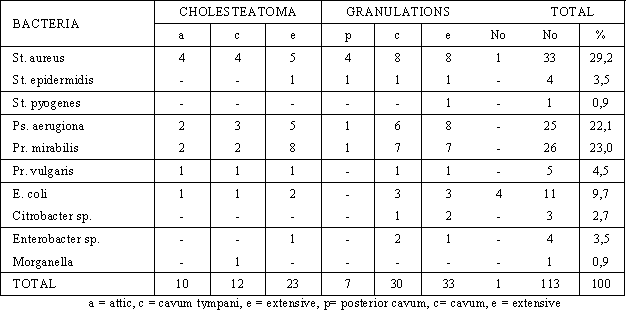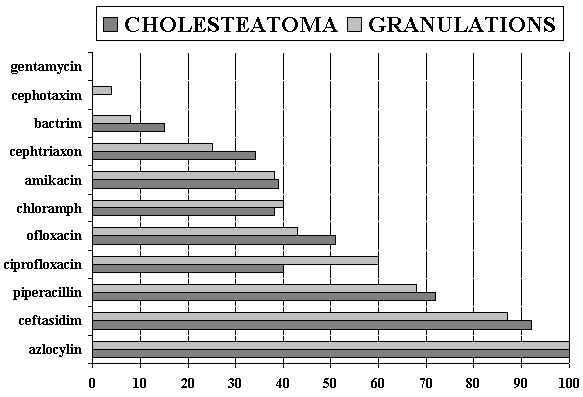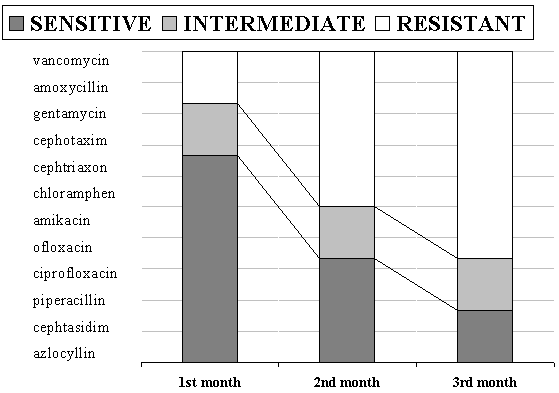

|
Journal Home Contents Preview Next |
Pro Otology
Balkan Journal of Otology & Neuro-Otology, Vol. 2, No 3:109-112 © 2002
All rights reserved. Published by Pro Otology Association
The Value of Preoperative Medicamentous Treatment of Chronic Otitis Media. Comparative Bacteriologic and Histomorphometric Study
*M. Stankovic, †D. Djordjevic, *D. Popovic, *E. Zivkovic, *†D. Mihailovic
*ORL Clinic, Medical Faculty Nis, Serbia, Yugoslavia †Institute for Microbiology, Medical Faculty Nis, Serbia, Yugoslavia *†Institute for pathology, Medical Faculty Nis, Serbia, Yugoslavia
ABSTRACT
Hypothesis: Adequate preoperative antibiotic treatment can reduce the intensity of pathological process and thus enable better conditions for tympanoplasty.
Background: Bacteriologic analyses of chronic otitis media indicate on polybacterial affection, especially in cases with cholesteatoma, with Ps. aeruginosa in 7-85%, and St. aureus in 6-33%. There are no histomorphometric investigations of middle ear mucosa in chronic otitis.
Methods: Prospective study that comprised 111 patient treated in ENT Clinic Nis was conducted. Isolation and identification of bacteria was performed, and their antibiotic susceptance and resistance was determined with disc diffusion method. Peroral or parenteral antibiotic therapy, according to these results, and local therapy were applied. Polypous tissue was removed preoperatively under operation microscope. Also, intraoperatively removed inflammatory tissue after therapy was used for histomorphometry. Number of inflammatory cells, fibroblasts, vascularization and vasodilatation were analysed parameters.
Results: The most frequently isolated bacteria form chronic otitis media are St. aureus (29,2%), Proteus sp. (27,5%), and Ps. aeruginosa (22,1%). There was no correlation between the type of pathological process and the type of bacteria. Polibacterial flora was more often in cases of cholesteatoma. Histomorphomery indicated that selective local and systemic antibiotic therapy reduces the number of inflammatory cells and blood vessels in chronic otitis media.
Key Words: Chronic otitis media, Bacteriology, Histomorphometry.
Pro Otology 3: 109-112, 2002
INTRODUCTION
Chronic otitis media is characterized by long lasting inflammatory process in middle ear space that does not respond to medicamentous treatment for at least three months. Adequate local and systemic medicamentous treatment can make ear dry and thus enable easier surgical intervention (1,3).
Bacteriologic analyses of chronic otitis media indicate on polybacterial affection, especially in cases with cholesteatoma, with Ps. aeruginosa in 7-85%, and St. aureus in 6-33% (3,6).
There are no histomorphometric investigations of middle ear mucosa in chronic otitis, especialy when preoperative antibiotic therapy is in concern.
Insufficient standardization of intensity of middle ear inflammation, type of reconstructive process, report of results and reasons for tympanoplasty failure demand further study of factors that significantly contribute to surgical treatment of chronic suppurative otitis media (2,4,6).
The aim of this study was: a) to identify bacteria responsible for chronic otitis media and their sensitivity and resistance to antibiotics, and b) to conduct histomorphometric study of middle ear mucosa after preoperative antibiotic treatment.
METHODS
Prospective study that comprised 111 patient treated in ENT Clinic Nis was performed. Diagnostic procedure included: anamnesis, clinical examination, bacteriology and histomorphometry of middle ear mucosa. Isolation and identification of bacteria was performed on automatic apparatus VITEK AMS, while their antibiotic susceptance and resistance was determined with disc diffusion method (Torlak, Belgrade). Peroral or parenteral antibiotic therapy, according to these results, and local therapy were done.
Polypous tissue was removed preoperatively under operation microscope. Also, intraoperatively removed inflammatory tissue after therapy was used for histomorphometry. Microscope Microphot FXA (Nicon) with objective x10 and Lucia M measuring programme were applied. Number of inflammatory cells, fibroblasts, vascularization and vasodilatation were analysed parameters. Statistical study with students t test and χ2 test was performed.
| Table 1. Bacteria isolated from chronic otitis media. |

|
RESULTS
Purulent secretion was verified in 85,6% cases with cholesteatoma, and 82,l% cases without cholesteatoma. Polybacterial flora was present in 23,5% of patients, especially in cases with extensive cholesteatoma (47,1%). The most frequent bacteria were St. aureus (29,2%), Proteus sp. (27,5%), Ps. aeruginosa (22,1%), and E. coli (9,7%) (Table 1).

|
|
Histogram 1. Sensitivity to antibiotics of pseudomonas aeruginosa. |

|
|
Histogram 2. Resistance to antibiotics of pseudomonas aeruginosa. |
| Table 2. Histomorphometry of chronic otitis media before and after antibiotic treatment. |

|
DISCUSSION
Bacterial flora is a very important factor in pathogenesis of chronic otitis media and significantly influence the type and intensity of osteolytic process. The rate of isolated bacteria in chronic otitis shows variations, with predomination of St. aureus, Ps. aeruginosa, Proteus sp., E. coli and other bacteria. The sampling technique can be the cause of such differences, especially when St. aureus is concerned. Anaerobic bacteria demand specific bacteriologic procedure, and their influence is not completely explained in pathogenesis of chronic otitis (4,6,7).
The result of this study indicate that isolated bacterial flora is not different than in other clinical references. Pathogenicity of Ps. aeruginosa is caused by: necrotic properties of local inflammation, chronicity, altered microcirculation, sequestration and uneasy elimination from middle ear space. However, antibiotic resistance of Ps. aeruginosa is one of the most important factors for failure of preoperative therapy of chronic otitis (3-6). Animal model of Ps. aeruginosa otitis can be used for analyse of influential factors in resistance and therapy of chronic otitis (8,9).Our investigations on resistance of Ps. aeruginosa on antibiotics correlates with other data from literature, except for high resistance to aminoglycosides (gentamycin in 99%, and amikacin in 62%). This process is complex, partly chromosomal, with production of enzymes that inactivate aminoglycosides (10-12).
Our results showed higher resistance rate in cases with cholesteatoma, which can be explained by higher incidence of polybacterial flora. Also, adequate prolonged local and systemic antibiotic therapy is mandatory for the success of preoperative treatment. The application of two antibiotics in therapy, according to sensitivity, gave better results in eradication of pathological process (13,14).
| Table 3. Histomorphometry of chronic otitis media with and without cholesteatoma. |

|
Chronic otitis media is histologically characterized by mucosal edema, vascular dilatation, cellular infiltration, osteolysis and osteogenesis (3-6). These parameters can be used for the study of results of therapeutic efforts.
This histomorphometric study showed that the number of inflammatory cells and blood vessels correlated with the intensity of process, and in cases with abundant polypous tissue without cholesteatoma it can be higher than in cholesteatoma. The type of bacterial flora is also very influential, with Ps. aeruginosa being the most important for increase of these parameters (15-16). The most valuable result of this analyse is that adequate preoperative antibiotic therapy can reduce the number of inflammatory cells and blood vessels in chronic otitis with or without cholesteatoma, and thus enable optimal conditions for tympanoplasty and better results of surgery.CONCLUSION
The most frequently isolated bacteria form chronic otitis media were St. aureus (29,2%), Proteus sp. (27,5%), and Ps. aeruginosa (22,1%). There was no correlation between the type of pathological process and the type of bacteria. Polibacterial flora was more often in cases of cholesteatoma.
According to histomorphometric study of granulations in preoperative period intraoperatively adequate, selective local and systemic antibiotic therapy can reduce the number of inflammatory cells and blood vessels in chronic otitis media.
REFERENCES
Kenna MA. Treatment of Chronic Suppurative Otitis Media. Otolaryngol Clin North Am 1994;27:457-72.
Wright CG, Meyerhoff WL. Pathology of Otitis Media. Ann Otol Rhinol Laryngol 1994;163:24-30.
Papastavros T. Preoperative Therapeutic Considerations in Chronic Suppurative Otitis Media. Laryngoscope 1989;99:665-59.
4. Brook I van de Heving PH. Microbiology and Management of Otitis media. Scand J Infect Dis 1994;93:20-32.Rotimi VO, Okeowo PA, Olabiyi DA, et al. The Bacteriology of Chronic Suppurative Otitis Media. East Afr Med J 1992;89:349-401.
Ibekwe AO, Shareef ZA, Beneyam A. Anaerobes and Fungi in Chronic Suppurative otitis media. Ann Otol Rhinol Laryngol 1997;106:649-52.
Heppt W, Lutz H. Clinical Experiences with Ofloxacin Sequential Therapy in Chronic Ear Infections. Eur Arch Otorhinolaryngol 1993;1:519-21.
Ryan AF, Hellstrom S, Barenkamp SJ, et al.. Animal Models of Otitis Media. Recent Advances in Otitis Media. Ann Otol Rhinol Laryngol 1989;98:33-8.
Davis SD. Interaction of Pseudomonas and the Host. Ann Otol Rhinol laryngol. 1988;131:13-5.
Tomasz A. Multiple Antibiotic Resistant Pathogenic Bacteria. N Engl J Med 1994;133:1247-51.
Pollack M. Special Role of Pseudomonas Aeruginosa in Chronic Suppurative Otitis Media. Ann Otol Rhinol Laryngol 1988;131:10-3.
Wiedemann B. An International Perspective on Antimicrobal Resistance. Am J Med 1995;99:19-20.
Narcy Ph. Etude de’l Efficacite et la tolerance de’l ofloxacine en solution suriculaire dans le traitment des otorrhees purulentes de’l enfant. Rev Soc Fr ORL 1997;41:29-36.
Arquedas AG, Herrera JF, Faingezicht I, et al. Ceftazidime for Therapy of Children with Chronic Suppurative Otitis Media without Cholesteatoma. Pediatr Infect Dis J 1993;12:246-8.
Ohashi Y, Nakai Y, Furuya H, et al. Mucocilliary Disease of the Middle Ear During Experimental Otitis media with Effusion Induced by Bacterial Endotoxin. Ann Otol Rinol Laryngol 1989;98:479-84.
Yoon TH, Paparella MM, Schachern PA, et al. Morphometric Studies of the Continuum of the Otitis Media. Ann Otol Laryngol 1990;99:23-7.
|
Pro Otology |
Journal Home Contents Preview Next |